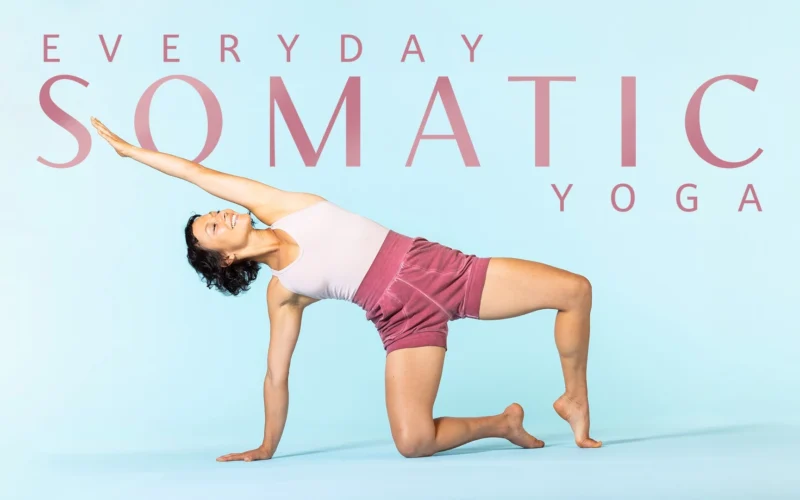Table of Contents Show
What Is Somatic Yoga?
Welcome to an exploration of somatic yoga, a unique form of movement therapy that combines the principles of yoga with somatic practices. Somatic yoga focuses on re-educating the brain to sense and move the muscles in a more functional way, leading to improved mobility, strength, posture, and reduced neuromuscular pain and symptoms.
Disclosure: As an Amazon Associate I earn from qualifying purchases.
Developed by Thomas Hanna and others, somatic yoga is rooted in the philosophy of body-mind integration. Through small, slow, and gentle movements, it relaxes and mobilizes tight or restricted muscles, promoting overall well-being. This mindful practice emphasizes internal perception and self-awareness, guiding you to develop a deeper connection with your body.
Discover the transformative effects of somatic yoga and embark on a journey of self-exploration and physical and mental transformation.
Key Takeaways
- Somatic yoga combines yoga and somatic practices for brain-muscle re-education.
- The practice involves gentle and slow movements to relax and mobilize muscles.
- Somatic yoga improves mobility, strength, posture, and reduces neuromuscular pain.
- Internal perception and self-awareness are central to somatic yoga.
- Embark on a transformative journey of self-exploration with somatic yoga.
Somatic Yoga Techniques
Somatic yoga incorporates a variety of techniques that are designed to promote body-mind integration and enhance self-awareness. By practicing these techniques, individuals can develop a deeper understanding of their body and cultivate a stronger mind-body connection.
Some of the key somatic yoga techniques include:
- Gentle and Slow Movements: Somatic yoga involves performing slow and gentle movements that help to awaken and re-educate the muscles. These movements are performed mindfully, ensuring that the focus is on internal perception and sensory awareness, rather than achieving specific external poses or shapes.
- Breathwork: The breath is an essential component of somatic yoga practice. By emphasizing conscious breathing techniques, individuals can deepen their awareness and bring attention to the present moment. Breathwork helps to foster relaxation, calm the nervous system, and support the integration of body and mind.
- Meditation and Body Scans: Somatic yoga often incorporates meditation and body scans as techniques to enhance self-awareness. Through meditation, individuals can cultivate a sense of inner calm and develop a greater understanding of their thoughts and emotions. Body scans involve systematically directing attention to different areas of the body, bringing awareness to sensations and promoting a sense of relaxation and release.
- Relaxation: Somatic yoga prioritizes relaxation as a means to release tension and stress from the body. By consciously relaxing the muscles and allowing the body to soften and unwind, individuals can experience a greater sense of ease and well-being.
- Guided Movement: In somatic yoga, guided movement refers to the practice of following verbal cues or instructions that encourage individuals to explore various ways of moving their body. By following guided movement sequences, individuals can awaken and engage different muscle groups, improve coordination, and promote overall mobility and flexibility.
Somatic yoga encourages individuals to trust their own senses and explore what feels good to them, rather than relying solely on external instructions. It is a practice that honors and celebrates the unique experiences and sensations within each individual’s body.
Comparison of Somatic Yoga Techniques
| Technique | Description |
|---|---|
| Gentle and Slow Movements | Performed mindfully to re-educate muscles and improve awareness |
| Breathwork | Conscious breathing techniques to deepen awareness and relaxation |
| Meditation and Body Scans | Cultivating inner calm and understanding through focused attention |
| Relaxation | Releasing tension and stress to promote ease and well-being |
| Guided Movement | Following verbal cues to explore different ways of moving the body |
By incorporating these techniques into their somatic yoga practice, individuals can deepen their self-awareness, enhance their physical well-being, and experience a profound sense of mind-body integration.
Benefits of Somatic Yoga
Somatic yoga offers a wide range of benefits that promote both physical and mental well-being. By incorporating gentle and mindful movements, somatic yoga helps individuals reduce stress, anxiety, and depression, creating a profound sense of relaxation and calming the nervous system. This practice fosters flexibility and strength, enhancing overall body awareness, posture, and mobility.
One of the primary advantages of somatic yoga is its ability to alleviate symptoms associated with chronically-tight muscles. Conditions like headaches, frozen shoulder, and breathing difficulties can be significantly improved through the practice of somatic yoga.
Additionally, somatic yoga fosters a self-compassionate relationship with the body, supporting emotional and physical balance. By engaging in this practice, individuals can cultivate a deeper connection with themselves and develop an increased sense of overall well-being.
Stress Relief and Emotional Well-being
Somatic yoga is particularly effective in reducing stress, anxiety, and depression. By incorporating relaxation techniques and gentle movements, this practice encourages the release of tension and promotes a calm and peaceful state of mind. Somatic yoga helps individuals navigate difficult emotions and provides an effective tool for managing stress in daily life.
Improved Flexibility and Strength
Through gentle and mindful movements, somatic yoga enhances flexibility and strength. This practice emphasizes the importance of listening to the body and moving in a way that feels good and nourishing. By gradually increasing range of motion and building strength, somatic yoga nurtures the body’s innate capabilities and encourages ongoing growth and development.
Enhanced Body Awareness and Posture
Somatic yoga cultivates a deeper awareness of one’s body. By focusing on internal perception and exploration, individuals develop a heightened sense of proprioception and kinesthetic awareness. This increased body awareness translates into improved posture and alignment, reducing the risk of muscular imbalances and related discomfort.
Alleviation of Chronically-Tight Muscles
Chronic muscle tension can lead to a range of symptoms and discomfort. Somatic yoga offers an effective approach to alleviate these issues. By engaging in gentle movements and releasing muscle tension through conscious relaxation, individuals can find relief from conditions such as headaches, frozen shoulder, and breathing difficulties.
Overall, somatic yoga provides a holistic approach to wellness, promoting physical and mental well-being through gentle movements, relaxation techniques, and enhanced body awareness. By incorporating somatic principles into their practice, individuals can experience the transformative benefits of somatic yoga, fostering a deeper connection to themselves and nurturing a balanced and harmonious life.
Somatic Yoga Practice and Teacher Training
If you’re interested in delving deeper into somatic yoga and becoming a certified teacher, there are various options available for somatic yoga practice and teacher training. Whether you prefer individual or group classes, or if you prefer the convenience of online learning or the immersive experience of in-person training, you can find a program that suits your needs.
Somatic yoga classes primarily take place on a yoga mat and do not require any special equipment. While you may encounter familiar yoga poses during somatic yoga practice, the focus is not on achieving a specific external form or perfecting the posture. Instead, the emphasis is on internal perception and exploration, allowing you to connect with your body on a deeper level.
In somatic yoga classes, instructors often provide verbal instructions that guide you through the practice while emphasizing self-awareness and personal agency. This encourages you to listen to your body’s cues and make choices that feel nourishing and comfortable for you. By cultivating this self-awareness, you can develop a greater sense of bodily intelligence and enhance your overall well-being.
If you’re passionate about sharing the transformative benefits of somatic yoga with others, you can consider enrolling in a somatic yoga teacher training program. These comprehensive programs provide in-depth knowledge of somatic practices, anatomy, teaching methodologies, and hands-on experience to equip you with the skills to become a certified somatic yoga teacher.
During somatic yoga teacher training, you’ll learn how to create a safe and inclusive space for your students, facilitate mindful movement and exploration, and guide others in developing their body-mind connection. You’ll also gain a deeper understanding of the principles and philosophy that underpin somatic yoga, allowing you to enrich your own practice and inspire others on their somatic yoga journey.
Somatic Yoga Philosophy
The philosophy of somatic yoga revolves around the concept of embodiment, recognizing that there is more to a human being than just the physical body. Somatic yoga encourages individuals to delve deep and connect with their bodies from within, fostering a profound sense of self-awareness. It promotes self-compassion, curiosity, and personal exploration, inviting practitioners to embark on a transformative journey of self-discovery.
In somatic yoga, listening to the body becomes paramount. It emphasizes the value of honoring one’s own experience and needs, making choices that feel nourishing and comfortable. Rather than focusing solely on external forms and appearances, somatic yoga prompts individuals to cultivate an internal perception of their bodies, to truly understand and sense the subtle sensations within.
This shift from a “doing” approach to a more experiential and mindful practice allows practitioners to explore the intricacies and potentials of their bodies. Somatic yoga encourages a deep connection with oneself, empowering individuals to trust their own instincts and explore the endless possibilities within their bodies.
When practicing somatic yoga, there is no judgment or comparison. It is about embracing the uniqueness of one’s own body and meeting it with acceptance and kindness. Somatic yoga invites practitioners to move away from societal expectations and external influences, and instead, cultivate an authentic connection with their bodies. It is a practice that honors individuality, celebrates diversity, and encourages self-expression.
By infusing the philosophy of embodiment into their practice, individuals can truly embody the essence of somatic yoga. The philosophy encourages growth, transformation, and self-empowerment, both on and off the mat.
Somatic Yoga and Mental Health
Somatic yoga is not just a physical practice; it is also a powerful tool for promoting mental health and emotional well-being. Through its emphasis on internal perception, relaxation, and self-awareness, somatic yoga can offer relief and support for individuals experiencing stress, anxiety, and depression. By exploring the body and emotions in a safe and therapeutic space, somatic yoga helps individuals release tension, regulate emotions, and create a more balanced state of being.
When we practice somatic yoga, we work with the body in a gentle and mindful way, allowing us to access the deeper layers of ourselves. This practice not only helps in rewiring the brain and nervous system but also provides a holistic approach to mental health and emotional well-being. By cultivating a greater sense of self-awareness, somatic yoga allows us to tap into the body’s wisdom and connect with our own inner resources for healing and growth.
One of the key benefits of somatic yoga for anxiety and depression is its ability to regulate the nervous system. Through slow and intentional movements, breathwork, and relaxation, somatic yoga helps activate the parasympathetic nervous system, which is responsible for rest and relaxation. This can help calm the mind, reduce anxiety symptoms, and provide a sense of grounding and stability.
Additionally, somatic yoga provides individuals with tools to manage stress and cultivate resilience. By bringing attention to bodily sensations and using gentle movements to release tension, somatic yoga helps individuals develop a greater capacity to navigate challenging emotions and situations. It offers a way to process and release stored stress and trauma on a physical, emotional, and energetic level.
Somatic yoga also fosters a deeper connection between the mind and body, allowing individuals to develop a more compassionate relationship with themselves. This means honoring one’s own experiences and needs, practicing self-compassion, and adopting a more mindful and embodied approach to self-care. By integrating somatic practices into daily life, individuals can cultivate greater emotional resilience and find peace in the present moment.
Overall, somatic yoga offers a unique approach to supporting mental health and emotional well-being. By combining movement, relaxation, and self-awareness, it helps individuals develop a greater understanding of their bodies and emotions. Whether it’s managing stress, reducing anxiety, or finding relief from depression, somatic yoga provides a powerful and transformative practice that can positively impact overall mental health and well-being.
Conclusion
Somatic yoga, a powerful practice combining movement, internal perception, and self-awareness, offers numerous benefits for both physical and mental well-being. With a focus on improving mobility, strength, posture, and promoting stress relief, somatic yoga provides a holistic approach to enhancing overall health. By embracing somatic principles within yoga practice, individuals can develop a deeper connection to themselves and foster a more compassionate relationship with their bodies.
One of the remarkable aspects of somatic yoga is its versatility, making it accessible to individuals of all ages and abilities. Whether practiced in classes or individually, somatic yoga can be adapted to various settings and preferences. Its gentle and mindful approach encourages self-exploration and internal understanding, empowering individuals to listen to their bodies and make choices that feel nourishing and comfortable.
By incorporating somatic movement therapy into their wellness routine, individuals can experience transformative effects on their mind, body, and spirit. Improved mobility and movement awareness can lead to enhanced physical performance and a greater sense of well-being. The practice’s emphasis on self-awareness and relaxation also contributes to stress reduction and an increased sense of overall calmness.
So, why wait? Begin your somatic yoga journey and unlock the myriad of benefits it offers. Embrace the power of movement, self-awareness, and internal perception to enhance your overall health and well-being. Whether you are seeking stress relief, improved strength and flexibility, or a deeper connection with yourself, somatic yoga has the potential to transform your life. Start exploring this transformative practice today!
You May Also Like: What Is Thai Yoga Massage?
FAQs
Q1. What is somatic yoga?
Somatic yoga is a form of movement therapy that combines elements of yoga with somatic practices. It focuses on re-educating the brain to sense and move the muscles in a more functional way, using small, slow, and gentle movements to relax and mobilize tight or restricted muscles.
Q2. What are some somatic yoga techniques?
Somatic yoga uses various techniques to promote body-mind integration, such as gentle and slow movements, breathwork, meditation, body scans, relaxation, and guided movement. The practice encourages individuals to trust their own senses and explore what feels good to them, rather than following external instructions.
Q3. What are the benefits of somatic yoga?
Somatic yoga offers a range of benefits for both physical and mental well-being. It can help reduce stress, anxiety, and depression, improve flexibility and strength, enhance body awareness, posture, and mobility, and alleviate symptoms related to chronically-tight muscles, such as headaches, frozen shoulder, and breathing difficulties.
Q4. How can I practice somatic yoga and become a teacher?
Somatic yoga can be practiced through individual or group classes, both online and in-person. It primarily takes place on a yoga mat and does not require any special equipment. There are also teacher training programs available for those interested in becoming certified somatic yoga teachers.
Q5. What is the philosophy of somatic yoga?
The philosophy of somatic yoga centers around embodiment and cultivating a deeper connection to oneself. Somatic yoga encourages individuals to explore and sense their bodies from within, promoting self-compassion, curiosity, and personal exploration. It emphasizes listening to one’s own body, making choices that feel nourishing and comfortable, and honoring individual experience and needs.
Q6. How does somatic yoga benefit mental health?
Somatic yoga has shown to be beneficial for mental health and emotional well-being. The practice’s focus on internal perception, relaxation, and self-awareness can help manage stress, anxiety, and depression. By working with the body in a gentle and mindful way, somatic yoga supports the release of tension, the regulation of emotions, and the rewiring of the brain and nervous system.
Q7. What are the overall benefits of somatic yoga?
Somatic yoga is a powerful practice that combines movement with internal perception and self-awareness. It offers numerous benefits for both physical and mental well-being, including improved mobility, strength, posture, stress relief, and a deeper connection to oneself. Somatic yoga provides a holistic approach to health and well-being.




